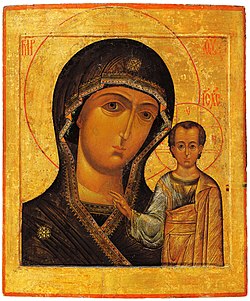Top Qs
Timeline
Chat
Perspective
October 22 (Eastern Orthodox liturgics)
From Wikipedia, the free encyclopedia
Remove ads
October 21 - Eastern Orthodox liturgical calendar - October 23

All fixed commemorations below celebrated on November 4 by Orthodox Churches on the Old Calendar.[note 1]
For October 22nd, Orthodox Churches on the Old Calendar commemorate the Saints listed on October 9.
From the Synaxarion
Saints
- Holy Equal-to-the-Apostles Abercius, Bishop and Wonderworker, of Hierapolis (167)[4][5][6][7]
- Hieromartyr Alexander, Bishop, and Martyrs Heraclius, Anna, Elizabeth, Theodota, and Glyceria, at Adrianople (2nd-3rd centuries)[4][6][8][9][note 2]
- The Holy Seven Youths ("Seven Sleepers") of Ephesus (250 and c. 446)[4][6][11][12] (see also: August 4 )
- Martyr Theodoret, at Antioch (362)[4]
- Venerables Lot[13] and Rufus,[14] of Egypt (5th century)[4][6][15]
- Saint Eulavios, Bishop of Lambousa (ancient Lapithos).[6][15][16][note 3]
Remove ads
Pre-Schism Western saints
- Saint Philip of Fermo, Bishop and martyr of Fermo in Italy (c. 270)[17][note 4]
- Saint Mellonius (Mellon), first Bishop of Rouen (314)[17][18][note 5][note 6][note 7]
- Saint Nepotianus, Bishop of Clermont in France (c. 388)[17]
- Saint Verecundus (Verecondo), Bishop of Verona in Italy (522)[17][note 8]
- Saint Simplicius, a disciple of St Benedict and third Abbot of Montecassino (c. 570)[17]
- Saint Maroveus, a monk at Bobbio Abbey and founder of the monastery of Precipiano near Tortona in Italy (650)[17]
- Saint Nunctus (Noint), Abbot of a monastery near Mérida in the west of Spain, murdered by robbers and venerated as a martyr (668)[17]
- Saint Moderan (Moderamnus, Moran), Bishop of Rennes, then became a hermit in Berceto in Italy (c. 730)[17][20][note 9]
- Saint Benedict of Massérac (Benoît de Macérac), a Greek abbot who fled from Petras and settled in Macerac near Nantes in France (845)[17]
- Saints Nunilo and Alodia, two sisters, a pair of child-martyrs from Huesca in Spain (851)[17][21][note 10][note 11]
- Saint Bertharius, a Benedictine abbot of Monte Cassino, martyred together with several of his monks by invading Saracens (884)[17]
- Saint Donatus of Fiesole, born in Ireland, he went on pilgrimage to Rome and became Bishop of Fiesole near Florence in Italy (874)[17][22][note 12]
Post-Schism Orthodox saints
- Saints Theodore and Paul, Abbots, of Rostov (1409)[4][18][23]
- Saint Gregory of Methoni, Bishop of Methoni in Greece and Ethnomartyr (1825)[15][24]
- Saint George the New Confessor, of Drama, Greece (1959)[4] (see also: October 24 - Russian; November 4 - Greek)
New Martys and Confessors
Remove ads
Other commemorations
- The Kazan Icon of the Most Holy Theotokos (commemorating the deliverance from the Poles in 1612)[4][18][25][26][33]
- Icons of the Mother of God "Andronikos"[34][35][note 15] and "Jacobstadt" (17th century)[18][25][26]
- Repose of Monk Joseph the Silent, of Kuban (1925)[4]
- Repose of Metropolitan Nestor of Kamchatka and Petropavlovsk (1962)[4]
- Repose of Protopresbyter Michael Pomazansky (1988)[4]
- Uncovering of the relics (2012) of New Hieromartyr Nikodim (Kononov), Bishop of Belgorod (1918)[25][note 16] (see also: October 20 )
Remove ads
Icon gallery
- Hieromartyr Alexander, Bishop, and Martyrs Heraclius, Anna, Elizabeth, Theodota, and Glyceria, at Adrianople.
- The Holy Seven Youths ("Seven Sleepers") of Ephesus.
- St. Mellonius, first Bishop of Rouen.
- New Hieromartyr Seraphim (Samoilovich), Archbishop of Uglich.
- Kazan Icon of the Most Holy Theotokos.
- Icon of the Mother of God of Andronicus.
- New Hieromartyr Nikodim (Kononov), Bishop of Belgorod.
Remove ads
Notes
- The notation Old Style or (OS) is sometimes used to indicate a date in the Julian Calendar (which is used by churches on the "Old Calendar").
The notation New Style or (NS), indicates a date in the Revised Julian calendar (which is used by churches on the "New Calendar"). - There is no record of his life and activity as a bishop, nor the period in which he flourished. However there are two different local traditions ascribed to him, taken from his acolouthia. In one local tradition it was widely reported that this holy shepherd was a Bishop in Edessa, Syria. Yet another Cypriot tradition relates that Eulavios was the Bishop of Lambousa (ancient Lapithos), and that he had nothing to do with the saint from Edessa.
- By tradition born near Cardiff in Wales, he became the first Bishop of Rouen in France.
- "Mellon had a vision, witnessed also by the Pope, commanding him to go and preach the Gospel in Neustria, or Normandy. He set out in obedience to the heavenly summons, and received in an extraordinary degree the gift of miracles, for the accomplishment of his work. Through his unwearied zeal and courage, and the many undeniable wonders wrought by him, the Faith of Christ made rapid progress in Rouen, and the Saint was happily constrained to erect a number of churches for their service. Mellon governed his church for many years, and when he felt his end approaching, retired to a solitary spot, where before long an Angel was sent to convey to him the happy message of his speedy deliverance."[19]
- Born in Rennes in Brittany, he became bishop there in 703. About the year 720 he made a pilgrimage to Rome and ended his days as a hermit in Berceto in Italy.
- Two sisters born in Adahuesca in Huesca in Spain. Daughters of a Muslim father and Christian mother, they were raised as Christians. After the death of their father, their mother married another Muslim, who brutally persecuted them and had them imprisoned. They were finally beheaded in Huesca during the persecution of Abderrahman II.
- See: (in Russian) Серафим (Самойлович). Википе́дия. (Russian Wikipedia).
- See: (in Russian) Андреев, Александр Александрович (протоиерей). Википе́дия. (Russian Wikipedia).
- See: (in Russian) Андрониковская икона Божией Матери. Википе́дия. (Russian Wikipedia).
- See: (in Russian) Никодим (Кононов). Википе́дия. (Russian Wikipedia).
Remove ads
References
Sources
Wikiwand - on
Seamless Wikipedia browsing. On steroids.
Remove ads







